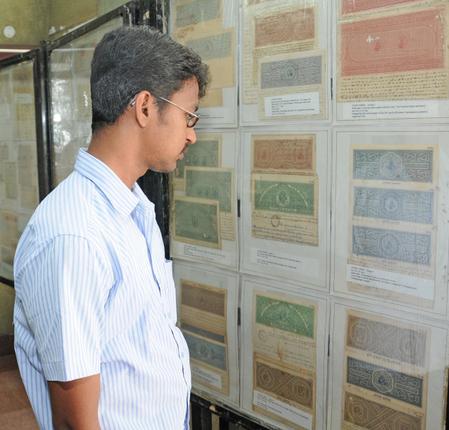Philately expo boasts of first ever revenue stamp, printed in 1860, among other artefacts
A student taking a look at some of the stamp papers on display at the exhibition at Head Post Office in Tiruchi on Saturday. / Photo: M. Moorthy / The Hindu
The monthly initiative of Tiruchi Philatelists Association to probe various themes through stamps has taken an interesting departure from the norm this time around. Though stamps are part of the exhibits, the spotlight is on documents of pre-independence India, predominantly dating back to the Victorian era.
The latest expo has two sections – the initial frames cataloguing printing errors challenge one’s attention to detail while the subsequent ones holding coffee coloured documents offer a peep into colonial India. Both exhibits are prize winning entries of an advanced philatelic capacity and are sure of hooking legal experts, those involved in commerce or trade and anyone with a penchant for records of a bygone era, according to association members.
Can you spot the bloopers?
Titled ‘Errors and omissions’, secretary of the association, J. Raghupathy’s cache reveals both blatant and diminutive errors caused by a printer’s negligence on stamps and postal stationery like postcards and inland letters.
Most of the errors can be spotted only on a sheet of stamps and are spotted by collectors who purchase stamps in bulk. “Error spotting is part of philately and is proof of how meticulously they study stamps,” says P.Soundararajan, president of the association. While many of the slip-ups can be spotted with the naked eye, it requires a magnifying glass to zero in on the error in some instances.
Though some bloopers nullify the value of the stamp, they escape the eye and end up at post offices including denominations cut off, perforated line running across the face of the stamp, mirror images, printing on cellotape, change of hues in multicoloured stamps, smudging or spread of ink and even an ‘India’ with a missing ‘I’.
Most of the errors were caused by negligence or dust in cylinders when stamps were printed through the photogravure process until the 1990’s. Though errors have reduced with digital printing, bloopers emerge every now and then, says Raghupathy.
The fiscals exhibits with documents and revenue stamps are vignettes of British India. “Fiscals are a relatively recent branch in philately; stamp papers and revenue stamps are also sold through post office,” says Soundararajan, the owner of the exhibits.
Among the exhibits are the first revenue stamp in India released on June 14, 1860 printed in pinkish paper with a lilac crown watermark and share certificates from the nineteenth century, hundi papers, foreign bills, promissory notes and shipping documents. A document issued by City Corporation of erstwhile Rangoon interestingly has a stamp featuring Rameshwaram temple.
Sale deeds with stamps from two annas to two hundred rupees offer an insight into registration fees and property prices during pre independence India.
Telegrams with stamps from an era where cost of the telegrams was indicated by special stamps, are also displayed. The Expo is on till October 15 at the Philatelic Bureau, Head Post Office, between 10 a.m. and 6 p.m. on all working days of the post office.
source: http://www.TheHindu.com / Home> News> Cities> Tiruchirapalli / by Olympia Shilpa Gerald / Tiruchi, September 20th, 2012
